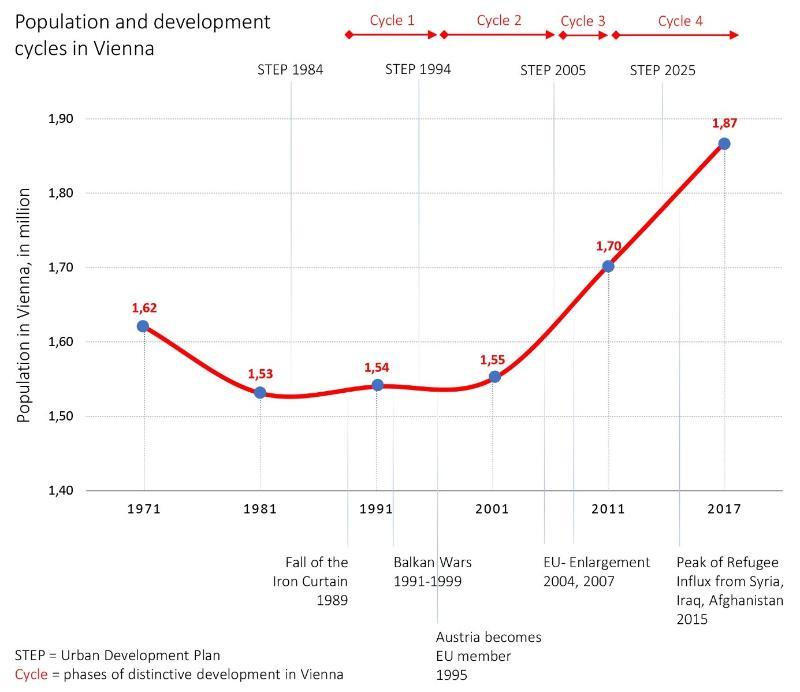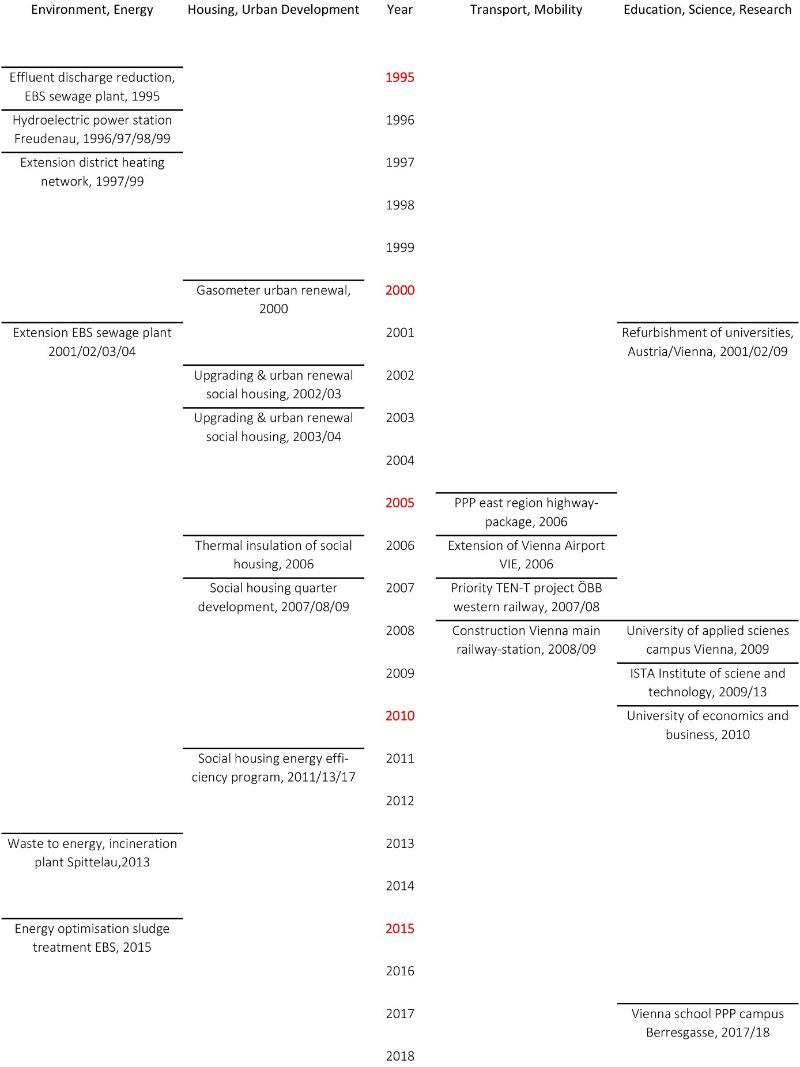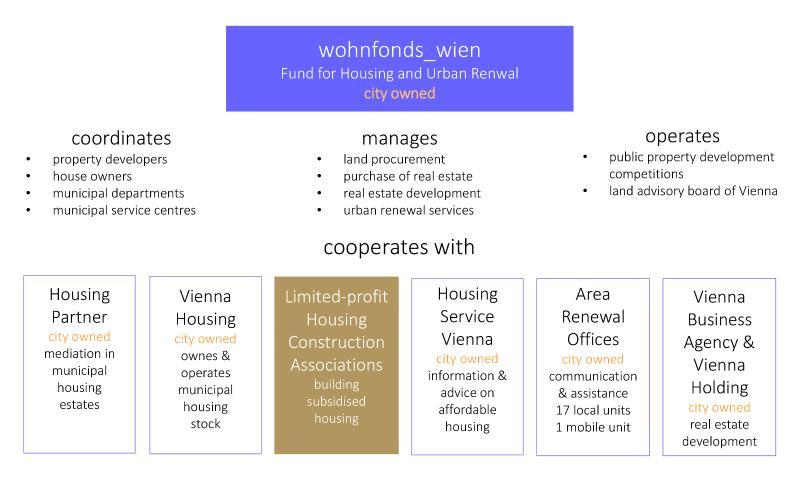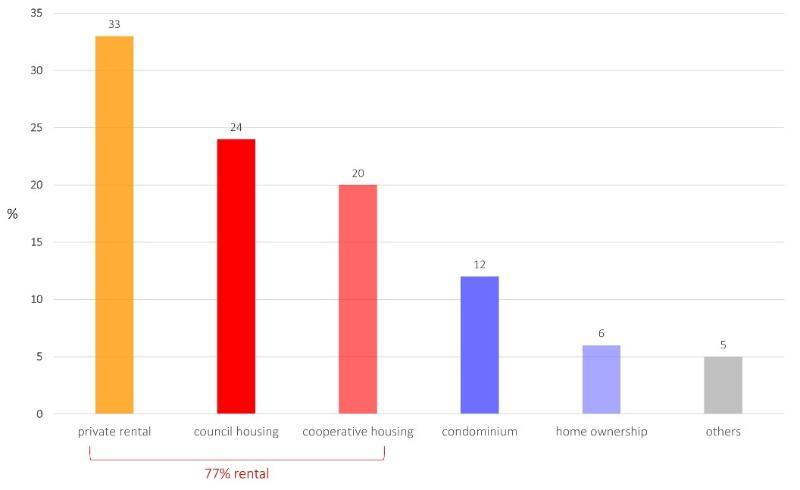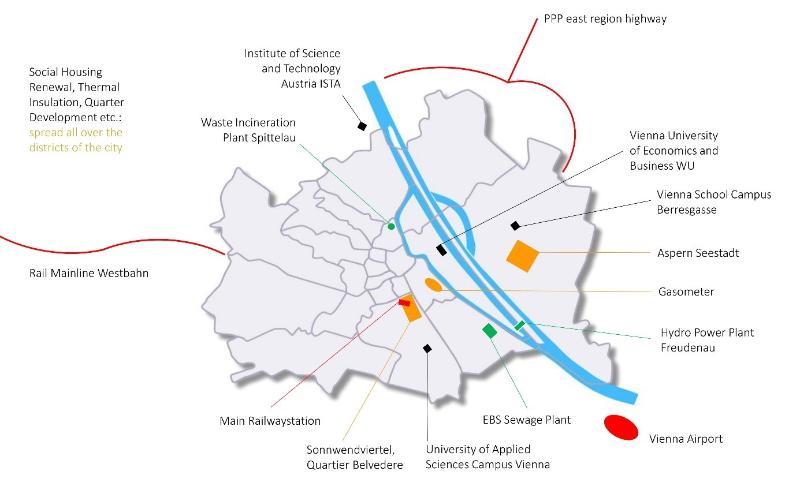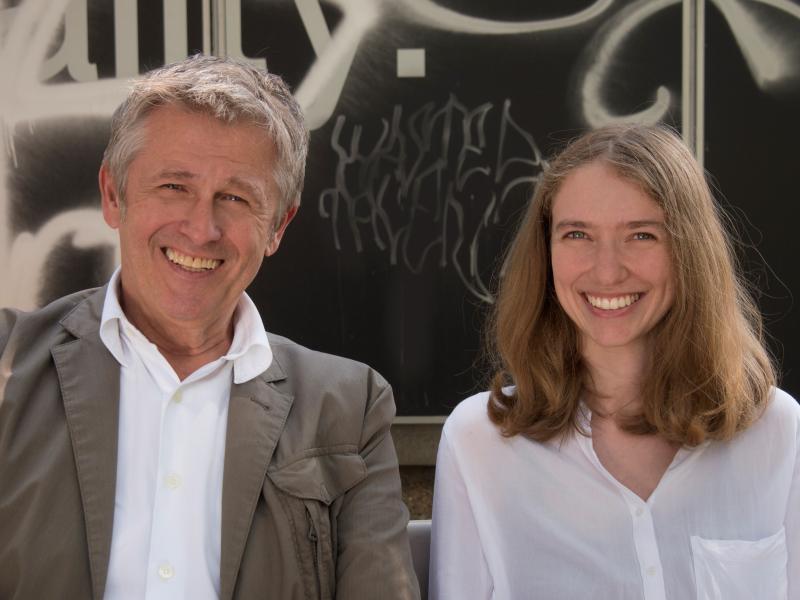Cycle 3: 2006-2010
Large-scale investment boosts Vienna’s competitiveness
This third development cycle is characterised by three main incidents and factors that had a great influence and impact on Vienna:
Implementation of large-scale investments
2006 to 2010 was the period where a bundle of large-scale infrastructure projects was carried out more or less simultaneously. This effectively upgraded Vienna and the Vienna Region as an internationally attractive location for business, research, tourism and living. These investments placed Vienna among the top ten in a ranking of large European cities regarding accessibility. [7] Most of the relevant investments concerned transport and research infrastructure, as well as new urban quarter development. It was the construction of two additional tracks on the western main railway to Vienna and the new main railway station of Vienna, the expansion of the Vienna Airport, the construction of main northern and eastern sections of the outer-ring motor-highway, new science institutions and a new university, and several new urban quarters.
Internationally attractive business location
From 2009 onwards, the international financial crisis made an impact on the economic development of Vienna by slowing down the city’s already moderate economic growth and by increasing unemployment in the context of Vienna’s still ongoing population growth. Between 2004 and 2014 the economic growth in Vienna amounted to 1.4% per year on average compared to 0.7% in the Eurozone. [8] Overall Vienna proved a robust business location because of its high labour productivity and its supply of innovative human capital. Due to the city’s advantages of highly skilled labour and a very high quality of life Vienna remained an attractive business location for international headquarters. Between 2009 and 2014 the number of international headquarters rose from 158 to 204. [9]
Changing political constellations
After four years of coalition between Social Democrats and Conservatives (1996-2000), Vienna was governed from 2001 to 2010 by only one party, the Social Democrats. To some degree, this majority allowed for more speedy and efficient decision making on strategies, planning and the implementation of crucial projects. While the period between 2001 and 2005 was characterised by comprehensive planning, the period between 2006 and 2010 was an intense phase of implementation. In the city’s local elections in 2010, the social democrats lost their majority and set up a coalition with the Green Party, the first coalition of this kind in Austria at a city level. The coalition with the Green Party (which continued after the elections in 2015 until now) caused a shift towards a more environmentally friendly and sustainable approach to (and understanding of) matters of urban development.
Upgrading transport infrastructure for international access
With the fall of the Iron Curtain, it became very evident that Vienna had been at the periphery of Western Europe and that some of its infrastructure for international travel fell short of European standards or was simply not available. A motor-highway and fast railway connections to the north (Brno) and east (Bratislava) did not exist. The accessibility of Vienna by train from the east and south was weak. From the west accessibility was better, but it was far from a high-speed connection. Vienna Airport did not have the capacity to cope with a rapid increase in air traffic.
Step by step motor-highways in the metropolitan region
Investment in transport infrastructure was an urgent objective, but this did not prompt action in all sectors immediately, so that many projects only started after the turn of the millennium. For example, arriving at the decision to close a section of 22 kilometres on the motor-highway between Vienna and Bratislava took more than a decade on the Austrian side. The construction itself then took only three years and by 2007 there was a complete motorway (A6) between the two capitals which facilitated business and tourist development in the region. Another important motor-highway package for better supra-regional accessibility to Vienna started in 2003. The project concerned the planning, construction, financing and operation of a new southern section of the Northern Motorway (A5), sections East-West on the Vienna Outer Ring Expressway S1 and section S2 on the Vienna Northern perimeter expressway. This project seeks to ease the congestion on arterial commuter routes into Vienna and enhance road links between Vienna and the Czech Republic. It forms moreover a part of a wider strategy to complete a ring road around Vienna. The project was run as a public private partnership of ASFINAG with the company Bonaventura. The realisation of the project, which received an estimated total investment volume of €825 million, was supported in 2006 by the EIB with a loan of €350 million. The construction was completed in 2010. In spring 2018 a positive decision for tunnelling the Danube as the centrepiece of this ring has been taken. This opens the opportunity to close the outer ring during the next years, although it has been heavily contested because of environmental concerns. For urban development in the east and south of Vienna and the development of the metropolitan region, it will be of high importance.
VIE Vienna Airport extension increases international accessibility
One of the most important projects regarding international accessibility – which was also extremely important for the development of tourism and international business in Vienna – was the extension of the Vienna Airport. As Austria was a neutral country during the Cold War, the Vienna airport in particular played a crucial role in the transit between East and West. In 1990 around 5 million passengers used the Vienna airport. Already two years earlier the airport company had expected growth and had planned an extension of the airport completed in 1996. Nonetheless, passenger and cargo traffic increased steadily. The number of passengers had already reached 11 million in 1999. Observing the trends very carefully Vienna Airport company published the “Masterplan 2015” [10] in 1998, to prepare for upcoming challenges and opportunities. Part of the masterplan was a proposal for the construction of a third runway and a terminal extension, Skylink, which would increase the airport’s passenger capacity to 24 million passengers a year. The design and planning of the Skylink terminal and associated facilities started in 2001, and the terminal opened in 2012. The design, construction and commissioning of the terminal and associated facilities was supported by the EIB with two loans in 2006 with a volume of €400 million. The total cost of the investment amounted to about €800 million. In 2017, a record 24.4 million passengers were processed and further extensions are being discussed. In contrast the preparation of the third runway was a more complicated undertaking. After a five-year mediation process, the construction is still on hold due to opposition and legal action from citizen’s initiatives, which has not yet been resolved. A final decision is expected in 2018.
Modernisation of the Austrian railway-system in Vienna boosts urban development
Austrian Federal Railways, ÖBB, led the reorganisation of the country’s rail traffic so that it would be in line with EU-regulations and TEN-T projects and to meet the new economic and logistic demands in the transport and cargo business. This became a topic of high importance in the 1990s and induced a lot of investment. This was the case in Vienna in particular, because the entire railway infrastructure, especially the decentralised railway stations and the areas for cargo handling, was outdated.
Two main decisions were taken by ÖBB very early on: First, the decision to overhaul the function and the number of decentralised terminal stations. This included the construction of a new main railway station in the form of a transit station for international travel with regional connectivity. In 2003 the City of Vienna and ÖBB signed a memorandum of understanding for joint planning of this infrastructure development. The new main station was also required to have a direct link to the Vienna Airport for international trains.
The second decision – taken earlier – was to concentrate the cargo handling areas in a new location in the metropolitan area of Vienna. Most of the old cargo areas had been in very central locations in the city. After lengthy negotiations between the City of Vienna and the real estate management of the ÖBB a solution with high urban development value for Vienna and high functionality for ÖBB was found. In the end, three large brownfields (former cargo areas) became the most important areas for new inner city urban developments in the first and second decade of the 21st century. These are the areas of the former North and North-West railway station and big parts of the former South-East railway station.
The new main railway station is located more or less on the former area of the South-East railway station. The first phase of construction began in 2010 and was finished in 2012, the full operation of the station started in 2014. In 2007 to 2009 the EIB approved an investment loan of a total €400 million to support ÖBB in realising this big infrastructure project, the overall costs were projected at €1 billion.
A new urban quarter with a business district, big park, housing and educational infrastructure began to develop on a brownfield area of 109 hectares near the main railway station. From 2020 onwards, more than 30,000 people are projected to live and work in this neighbourhood (Sonnwendviertel, Quartier Belvedere. [11] It is constructed with the intention of connecting to the neighbouring areas of the 10th Vienna district and bring new life into this older urban area.
Improving international and inner-urban high-performance rail-bound transport
To unlock the full capacity and attractiveness of a modern railway system and new railway station in terms of shortening travel times, thus gaining full added value for the project, it was necessary also to modernise the “Westbahn” rail mainline heading to Vienna. With an investment loan of €400 million in 2007 to 2008 the EIB contributed to the construction of two additional tracks on the Priority TEN-T Railway section between Vienna and St. Pölten, which induced a total investment volume of around €1.45 billon.
In addition to these three big transport infrastructure investments, which were of high importance for Vienna and Austria, the City of Vienna also invested heavily in the extension of the Vienna underground system. The two underground-lines U1 and U2 were extended between 2001 and 2008. The underground U2 was extended in particular to connect to the Vienna football stadium in time for the European Championships in 2008. The investment volume for both extensions was around €758 million. It was financed 50:50 by the City of Vienna and the federal state. [12]
Science and research as incubators for urban development
In line with the increased discussions about the internationalisation of Vienna and improving its standing worldwide, the city paid more and more attention to the science and research sector. As the biggest university city in German-speaking Europe with nearly 186,000 students [13], Vienna emphasized science and research. This was seen as an important incubator for urban development and economic growth. The paradox for Vienna is that universities are under the responsibility of the federal state and therefore the direct influence of the city in this area is weak. But the municipal government contributes to the development of Vienna as an attractive science and research hub in other ways, for example by financing R&D infrastructure, by providing advisory services for research companies and research programmes for individuals, by supporting institutes and R&D focused companies. Between 2002 and 2011 the number of R&D units in the city increased from 1,032 to 1,487. The number of employees grew from 16,551 to 20,717 and the expenses for R&D facilities located in Vienna increased from €2 billion to €2.9 billion, of which the public sector financed between 40% and 50%. [14]
Two big investments in university and research institutions in Vienna and the Vienna Region raised the international visibility of Austria’s capital significantly.
First, the construction of the new campus of the Vienna University of Economics and Business (WU). After just four years of construction (2009-2013), WU’s new, modern campus with approximately 90,000 m² of net floor area was completed on an area between the Messe Wien exhibition grounds and the Prater Park in 2013 and is directly accessible by the underground line U2. It is Vienna’s first “campus university,” consisting of six building complexes built by famous international architects: Zaha Hadid, Peter Cook, Hitoshe Abe, NO.MAD architects, BUS architecture and Estudio Carme Pinós S.L. As the university moved into its new location in the second district, it led to a transformation of this former “red light” and “workers district.” The university still generates a lot of new investments in this area of the district today. The former location of the WU in the ninth district has now been turned into a new inner-city development area, for which the planning started in recent years. The realization of the new university campus with a total investment of around €500 million was supported by two investment loans of the EIB in 2010 of €250 million.
A second significant project for the knowledge economy in the Vienna region to receive EIB financing was the construction of the newly founded Institute of Science and Technology Austria (ISTA), which began in 2009 and was completed in 2015. The project’s construction costs amounted to €112 million, the EIB invested €56 million and, later, an additional €42 million for an extension (total extension costs €84 million). ISTA carries out fundamental research in natural sciences, mathematics and computing and benefits from its proximity to Vienna and its science and research institutions. (ISTA is located in Klosterneuburg, a municipality with around 30,000 inhabitants that borders directly to Vienna.)
Besides these big projects, the EIB contributed to the education infrastructure and knowledge economy of Vienna and Austria several times during the first decade of the 21st century. In 2009 it invested €35 million in the new construction of the University of Applied Sciences Campus Vienna (4,000 students). Between 2001 and 2010 the EIB supported BIG (Bundesimmobiliengesellschaft), the Austrian real estate company for federally owned institutions, with loans for the refurbishment and construction of primary and secondary schools and universities, many of them located in Vienna. The total amount of EIB loans in this period was €450 million.
Affordable housing: an ongoing challenge in refurbishment and new construction demands
In this cycle, the construction of a lot of new housing subsidized by the city of Vienna started to take place. Nonetheless, the city also continued its urban renewal and social housing rehabilitation offensive. The main objective was to upgrade the rental social housing stock so that it could meet contemporary housing quality standards by improving basic sanitation, increasing thermal insulation and substantially reducing energy consumption. With loans amounting to €315 million, the EIB contributed substantially to this very important housing investment by the City of Vienna between 2007 and 2008. Again, Wiener Wohnen (Vienna Housing) was the promoter and financial intermediary as well as the operator of the programme. Nearly 15,000 dwellings could be renovated between 2008 and 2010. A special rehabilitation program for thermal insulation in social housing was also supported by the EIB with a framework loan of €100 million in 2006.
